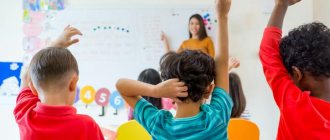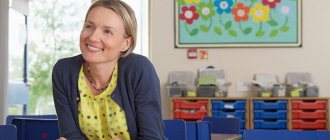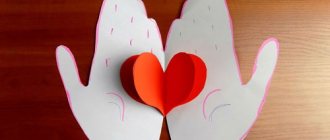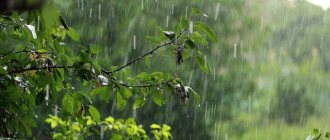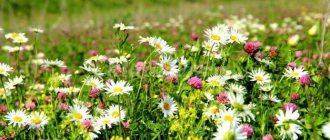Self-analysis of the teacher
MBOU PSOSH No.-1 Structural unit Pozhvinsky kindergarten Berezka
Introspection
pedagogical activities for the 2018-2019 academic year
Educator: Kochegina Alevtina Fedorovna
Pozhva village 2021
Self-analysis of the pedagogical activities of the preparatory group “Gnomes” for the 2018-2019 academic year.
During the 2018-2019 academic year, I built the entire educational process with children on the basis of an exemplary general educational program for preschool education “From birth to school”
edited by N. E. Veraksa, T. S. Komarova, M. A. Vasilyeva.”
All my teaching activities are carried out in accordance with the Federal State Educational Standard, which establishes a system of norms and requirements for the content of education and training, and children’s mastery of key components in a kindergarten setting.
Students' mastery of the educational program by region can be seen in the dynamics of growth in results. A comparative analysis of the level of development of children in the group can be tracked in monitoring, which is carried out with children 2 times a year in September and May.
This school year there are 22 children aged 5 to 7 years in the preparatory group. According to the results of the final monitoring, good results were achieved in children’s mastery of the program, in accordance with the Federal State Educational Standards targets.
During the monitoring of children, it was revealed that children are inquisitive, responsive, and have self-care skills. At the beginning of the school year, some children had a lack of skills and abilities in some educational areas (Sasha D., Timosha G. Sofia I.)
By the end of the school year, there is an increase in the level of knowledge in all educational areas.
Integration of educational areas is represented by “Cognitive Development”
,
“Social and communicative development”
,
“Speech development”
,
“Artistic and aesthetic development”
,
“Physical development”
.
The effectiveness of educational activities in educational areas of the program.
Educational field "Speech development"
| Beginning of the year | The end of the year | |
| High level of development | 0 % | 50% |
| Average level of development | 50% | 60% |
| Low level | 50% | 0% |
Educational field "Speech development"
implemented through the formation of a dictionary, teaching the sound culture of speech, worked on grammatical structure and the formation of coherent speech in children. At the same time, she took into account the peculiarities of the child’s vocabulary and ability to pronounce sounds in words. To develop speech, I used all routine moments and everyday situations.
By the end of the year, children's vocabulary increased significantly, and the use of words denoting an emotional state, ethical qualities, aesthetic characteristics, and various properties and qualities of objects became more active. Many children learned to isolate the first sound in words and use compound and complex sentences. The children showed good results in retelling the content of short works of art, telling a story based on a picture, and memorizing poems.
To implement all the tasks set for this section, I made and purchased games for the development of speech and familiarization with the environment, systematized card indexes, collections of illustrations, etc.
Educational field "Cognitive development"
| Beginning of the year | The end of the year | |
| High level of development | 0% | 64% |
| Average level of development | 59% | 36% |
| Low level | 1% | 0% |
Throughout the school year, I improved the children’s ability to perform actions with objects that differ in size, size, color, shape, distinguish and name the seasons by external signs, recognize and name the time of day, notice changes in the weather and differences in nature.
I paid much attention to the development of sensory motor skills of the hands, the development of fine muscles of the fingers, taught children perseverance, consistency in completing tasks, and understanding of the cause-and-effect relationship between objects. I taught children to support the child’s natural desire to explore objects, objects and phenomena of the immediate environment.
In direct educational activities, she taught children to look at a sample, identify parts in it, determine what parts it is made of, and developed the ability to navigate in space.
Children distinguish objects by shape and size; know what parts a group of objects is made of, name their characteristic features (color, shape, size)
. Many children can navigate the space around them.
As a result of daily observations in nature, children became acquainted with seasonal changes in nature, learned to distinguish and name the seasons. Through the use of games “When does this happen?”
,
“Describe, I can guess?”
,
“What first, what then?”
,
“Does this happen or not?”
,
“Seasons”
,
“Animals”
,
“Plants”
- consolidated the children’s acquired knowledge and ideas about the natural world.
She paid attention to expanding children’s understanding of the world around them: she taught them to distinguish and name types of transport, and introduced them to the rules of behavior in public places. For this purpose, I conducted conversations and organized viewing of story-based pictures, in which children not only became acquainted with the rules of behavior, but also learned to assess the situation. Through the use of the game "Professions"
continued to introduce children to the work of adults, the results of their work, and cultivated respect for the work of adults.
The data obtained as a result of the monitoring at the beginning and end of the school year indicate the effectiveness of the work carried out.
Educational field “Artistic and aesthetic development”
| Beginning of the year | The end of the year | |
| High level of development | 14% | 82% |
| Average level of development | 68% | 18% |
| Low level | 18% | 0% |
Over the course of the year, I developed a desire and interest in drawing in children, so all children are happy to engage in productive activities. I continued to teach children skills in using a variety of drawing media and methods (pencil, brush, gouache and crayons; stroke, line, vertical and horizontal straight and wavy lines). She introduced children to unconventional drawing techniques: cotton swabs, fingers.
During modeling classes, children created images of various objects and toys, combined them into a collective composition, and were able to use a variety of learned techniques.
In the appliqué, she continued to teach children the rules of using scissors, cutting out objects in straight and round shapes, carefully sticking images of objects, making patterns and compositions.
Educational field “Social and communicative development”
| Beginning of the year | The end of the year | |
| High level of development | 0% | 41% |
| Average level of development | 32% | 55% |
| Low level | 68% | 5% |
I realized the social and communicative development of children through thematic conversations, game situations, playing sketches, imitating movements. Children developed goodwill, responsiveness, the ability to respond to another person’s greeting, politely express their request, thank them, and encouraged children to interact with each other and with unfamiliar adults. Developed in children the ability to see different emotional states of close adults and children (joy, sadness, anger)
. She paid attention to the safety of children’s life activities during the day indoors and on walks, while listening to fairy tales, looking at pictures and subject cards, and introduced children to the basics of safe behavior in everyday life, in society, and in nature. Throughout the year, she taught me to follow the rules of behavior when playing with sand, water, and small objects.
Children received elementary ideas about a person: about themselves, about boys and girls, close relatives, and became acquainted with parts of the human body: head, torso, arms, legs. She instilled in them a sense of satisfaction from cleanliness and order, and taught them to be attentive to the instructions of adults.
She paid a large role to the development of moral qualities of the individual and the patriotic education of each child.
Educational field "Physical development"
| Beginning of the year | The end of the year | |
| High level of development | 0% | 41% |
| Average level of development | 32% | 55% |
| Low level | 5% | 68% |
To ensure the conditions for the physical development of children of the sixth year of life, I carried out an individual approach to each child. Throughout the year, children were provided with full hygienic care, strict adherence to the regime, protection of life and the nervous system, prevention of fatigue and injury, and development of motor skills.
I organized physical exercises in a playful way. She taught children to play collective outdoor games. Throughout the year, I continued to teach and reinforce children’s basic personal hygiene skills, develop self-care skills, and mutual assistance.
In my work I use various forms of training: traditional, integrated, complex, combined classes. As well as various techniques: the use of clarity, playful, surprise moments, the method of problem situations, search activities, etc.
In the group, I organized the subject-spatial environment. It is developmental in nature.
Play areas are organized in accordance with the age of children and their individual needs. There is educational and developmental material: didactic games, models, puppet theaters, costumes, masks; Thematic toys are presented: dolls, cars, etc. There are corners with large furniture for role-playing games.
Every day I try to maintain a friendly psychological atmosphere in the group, creating favorable conditions for the physical and psycho-emotional comfort of children. I try to establish contact with each child, win him over, arouse and maintain interest in children visiting kindergarten.
Working with family
I try by all available means to achieve interaction and agreement with parents in nurturing a common culture for children and in creating an emotionally favorable climate.
During the school year, goals and objectives were set: to unite the efforts of the family and kindergarten for the education and development of a preschooler.
Disseminate pedagogical knowledge among parents;
Provide practical assistance in raising children;
Contribute to the establishment of a trusting relationship between parents and group educators: respond adequately to the recommendations of group educators, make efforts to establish partnerships with educators to solve the problems of raising a child.
In the reception group there is a parent corner and stands “For you parents”
,
“Health Corner”
,
“Psychologist’s Recommendations”
, mobile folders containing information for parents and recommendations, as well as exhibitions of children’s works on artistic creativity.
Throughout the year, parents were consulted on their children’s progress and other pressing issues, parent meetings were held, the material in the parents’ corner was constantly updated in accordance with the season, and the topics of safety, health, and hardening of children were addressed. The survey method was used to identify problems and pressing issues. Families made many crafts for exhibitions, held events, leisure activities, holidays, and entertainment together.
The children of our group, together with their parents, actively took part in competitions:
- Symbol of the year;
- Municipal competition “Pozhvinsky stars” 2018-2019.
- "Gifts of Autumn";
- Municipal competition “Burning Bush” (3rd place, 5th class);
- Regional competition “Bonfire of Memory” (4 lessons);
- Participation in the festival of children's creativity in the categories: “Choreography” and “Fine Arts” (14 participants);
- Arts and crafts “Easter joy”;
She took part in competitions, craft exhibitions, and events held within the preschool educational institution:
- International competition “Me and Flowers”
- All-Russian competition "Symbol of the Year"
- Regional traffic rules competition (3rd place).
In the future, I plan to continue working on professional self-development and self-improvement, as well as creating a favorable psychological microclimate in the group and in working with the families of students, studying new technologies and methods in raising and teaching children. Improving your teaching competence.
7+
In the parent's corner there is a place for the section “Territory of Creativity” - children's works in fine arts, modeling, and manual labor are demonstrated. It is better to introduce parents to this or that issue of upbringing through folders - transfers, consultations. Usually thematic material with practical recommendations is selected. The leisure area in working with parents turned out to be the most difficult in the organization.
Info
This is explained by the fact that some parents are very busy at work, while others do not want to take part in activities. But such parents turned out to be few. Mothers gladly took part in the event, an unconventional meeting “My Beloved Mommy” with the participation of mothers.
